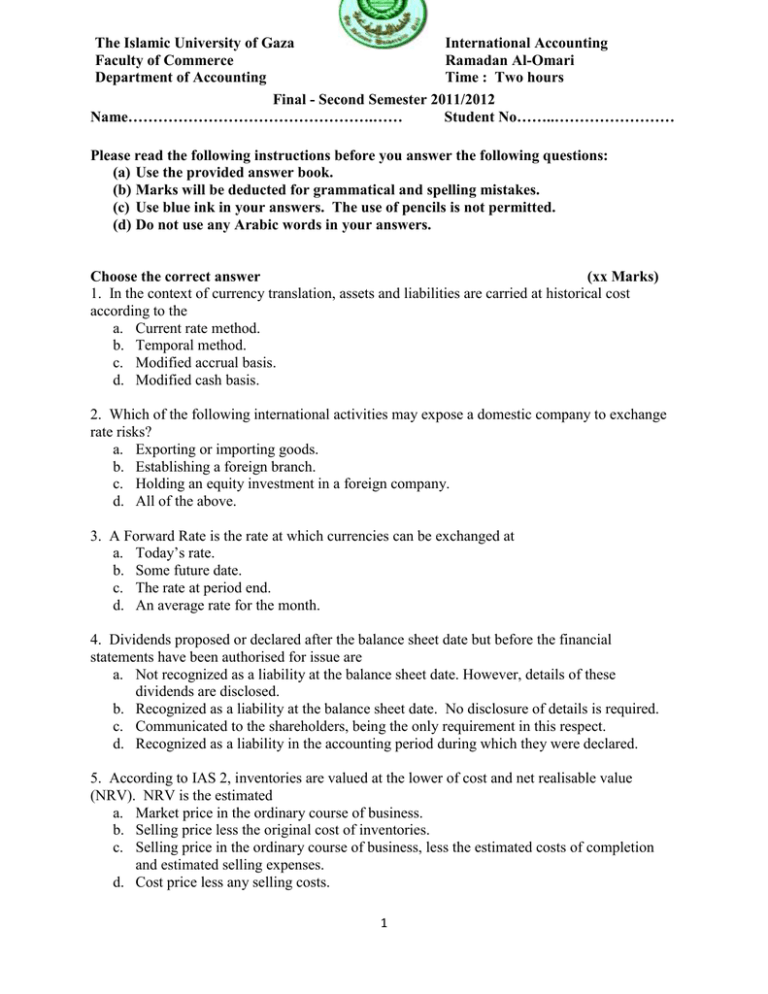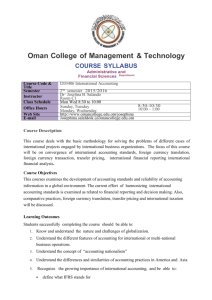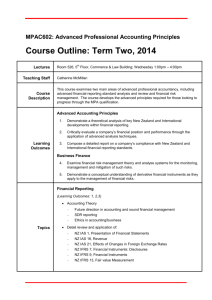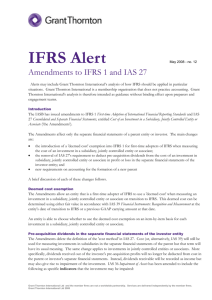Final - Second Semester 2011/2012 International Accounting The
advertisement

The Islamic University of Gaza International Accounting Faculty of Commerce Ramadan Al-Omari Department of Accounting Time : Two hours Final - Second Semester 2011/2012 Name………………………………………….…… Student No……..…………………… Please read the following instructions before you answer the following questions: (a) Use the provided answer book. (b) Marks will be deducted for grammatical and spelling mistakes. (c) Use blue ink in your answers. The use of pencils is not permitted. (d) Do not use any Arabic words in your answers. Choose the correct answer (xx Marks) 1. In the context of currency translation, assets and liabilities are carried at historical cost according to the a. Current rate method. b. Temporal method. c. Modified accrual basis. d. Modified cash basis. 2. Which of the following international activities may expose a domestic company to exchange rate risks? a. Exporting or importing goods. b. Establishing a foreign branch. c. Holding an equity investment in a foreign company. d. All of the above. 3. A Forward Rate is the rate at which currencies can be exchanged at a. Today’s rate. b. Some future date. c. The rate at period end. d. An average rate for the month. 4. Dividends proposed or declared after the balance sheet date but before the financial statements have been authorised for issue are a. Not recognized as a liability at the balance sheet date. However, details of these dividends are disclosed. b. Recognized as a liability at the balance sheet date. No disclosure of details is required. c. Communicated to the shareholders, being the only requirement in this respect. d. Recognized as a liability in the accounting period during which they were declared. 5. According to IAS 2, inventories are valued at the lower of cost and net realisable value (NRV). NRV is the estimated a. Market price in the ordinary course of business. b. Selling price less the original cost of inventories. c. Selling price in the ordinary course of business, less the estimated costs of completion and estimated selling expenses. d. Cost price less any selling costs. 1 6. A component of an enterprise that may earn revenues and incur expenses, and about which management evaluates separate financial information in deciding how to allocate resources and assess performance is a(n) a. Identifiable segment. b. Operating segment. c. Reportable segment. d. Industrial segment. 7. Currency Translation is the process of a. Hedging a foreign currency against exchange rate fluctuations. b. Aggregating the foreign currency with the local currency. c. Expressing amounts stated in a foreign currency in the currency of the reporting entity. d. Converting the holding company’s financial statements to the currency of its subsidiary. 8. IAS 2, ‘Inventories’, requires the cost of items that are not interchangeable or that have been segregated for specific contracts to be determined a. On an individual-item basis. b. by using the first-in, first-out (FIFO) method c. on the basis of the weighted average cost formula. d. On the basis of the Last-in, first-out (LIFO) method. 9. A Floating Rate is the rate between major currencies as determined by a. Central banks. b. Local banks. c. Forward contracts. d. Supply and demand factors. 10. A foreign subsidiary is consolidated if the parent company owns, directly or indirectly, a. More than 50% of the stock of the subsidiary company. b. A controlling interest in the voting stock of the subsidiary. c. Any number of shares. d. A majority of non-voting shares. 11. According to the Temporal Method of currency translation, monetary assets and liabilities are translated at the a. Current exchange rate. b. Historical exchange rates. c. Average rate for the year. d. Rate at the beginning of the financial period. 12. According to the Temporal Method of currency translation, assets and liabilities are a. Carried at historical cost. b. Current exchange rate. c. Rate at the beginning of the financial period. d. Rate at the date of declaring the dividends. 2 13. According to IFRS 1, First-time adoption of IFRS, an entity moving from national GAAP to IFRS should apply the requirements of IFRS 1. a. It applies to an entity’s first IFRS financial statements. b. It applies to an entity’s financial statements issued at the end of its first financial period. c. It only applies to entities that are established after the effective date of IFRS 1. d. It is applicable to listed companies only. 14. According to IAS 1, financial statements are prepared on a going concern basis unless management a. Intends to liquidate the entity b. Plans to cease trading. c. Believes that the going concern basis is not valid any more. d. All of the above. 15. Notes to the financial statements are a. An integral part of the financial statements because they provide information additional to the amounts disclosed in the ‘primary’ statements. b. Not an integral part of the financial statements because they are optional. c. Not relevant because they are not subjected to any audit requirement. d. Required only by entities seeking listing in a stock exchange. I. Accounting policies, accounting estimates and errors – IAS 8, states that “Management uses its judgment in developing and applying an accounting policy that results in information that is relevant and reliable”. a. State what are the qualities of “reliable information”; and b. Explain how management should deal with issues when there is no IFRS standard or interpretation that is specifically applicable; II. According to IAS 10, “Events after the reporting period and financial Commitments” the carrying amounts of assets and liabilities at the balance sheet date are adjusted only for adjusting events or events that indicate that the going concern assumption in relation to the whole entity is not appropriate. a. b. c. d. Explain what is meant by “events after the reporting period”. Explain what is meant by an adjusting event; State how non-adjusting events should be dealt with in the financial statements; Explain what is meant by the “going concern” assumption. III. According to IAS 40, “Investment property”, certain properties are classified as investment properties for financial reporting purposes. 3 a. State how investment property differs from owner-occupied properties; b. State the purpose for holding investment properties by an entity; c. State the choice given by IAS 40 to management in measuring the value of an investment property for balance sheet disclosure purposes; and d. State the definition of “Fair value” as explained by IAS 40. IV. According to IAS 36, “Impairment of assets”, nearly all assets - current and non-current are subject to an impairment test to ensure that they are not overstated on balance sheets. The basic principle of impairment is that an asset may not be carried on the balance sheet at above its recoverable amount. a. State how the “recoverable amount” is defined in IAS 36; b. Explain how the “value in use” is estimated according to IAS 36; and c. Give two examples of an impairment indicator as mentioned in the above IAS. V. IAS 11, “Construction contracts” states that “Revenue and expenses on construction contracts are recognised using the percentage-of-completion method” a. State what constitutes contract revenue and expenses; and b. State when an entity shall recognize losses on construction contracts. Question No. 3. (10 Marks) On January 1, 2011, Real Madrid Sports Systems, a European based company, purchased a controlling interest in Al-Zamalek Sports Club operating in Cairo, Egypt. The 2011 financial statements stated in Egyptian Pounds are given below: Al-Zamalek Sports Club Balance Sheet as at December 31, 2011 Cash and Receivables Fixed Assets Total Accounts Payable Common Stock Retained Earnings Total 45,000 45,000 90,000 ===== 30,000 40,000 20,000 90,000 Al-Zamalek Sports Club Income Statement For the year ended December 31, 2011 Revenues 65,000 Operating Expenses 40,000 Net Income 25,000 Dividends declared and paid 10,000 Retained Earnings 15,000 ===== 4 ===== You are required to translate the year end income statement and balance sheet of the foreign subsidiary using the current rate method of translation and the following exchange rates for the Egyptian Pound: Date January 1, 2011 December 31, 2011 Average for 2011 Dividend payment date Egyptian Pounds Per Euro 7.80 7.70 7.50 7.40 Question No. 2. (10 Marks) On 5 April, 2012, Bayern Munich Ltd, a German firm, purchased inventory for US$ 300,000 payable on July 5, 2012. The firm’s financial year end is 30 April. The reporting currency is the EURO. On 5 April, 2012, Bayern Munich Ltd entered into a forward contract to buy US$ 300,000 on July 5, 2012. The spot rate for (Euro/US$) and the forward rates are as follows: Date __________________ 5 April, 2012 30 April, 2012 5 July, 2012 Spot Rate ___________________ 1.31 1.32 1.34 Forward Rate (for July 5)___ 1.33 1.35 You are required to prepare the journal entries necessary to record the purchase of inventory and the forward exchange contract, including those at year end and on the settlement date in the books of Bayern Munich Ltd. Question No. 1. (10 Marks) Chelsea Ltd, a manufacturing company, operates in six different segments. Information concerning the operations of these segments for the year ended 30 April 2012 is as follows: All figures are in GBP. Tires Steel Electronics Painting upholstery Assembly 5 Revenue - external Revenue - internal Operating Profit Identifiable Assets 22,000 8,000 (4,800) 10,000 78,000 12,000 19,000 80,000 60,000 10,000 16,000 20,000 28,000 2,000 (3,200) 8,000 56,000 14,000 15,000 15,000 24,000 6,000 5,000 12,000 You are required to: (a) Determine the reportable segments; (b) Indicate whether the identified reportable segments represent a significant portion of Chelsea Ltd; (c) Indicate what should be done if the requirement in (b) above is not met; and (d) State how the non-reportable segments, if any, should be presented in the Financial Statements. GOOD LUCK 6





